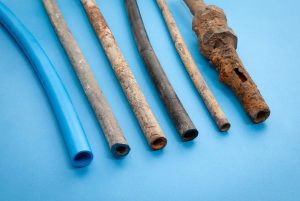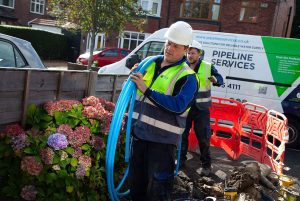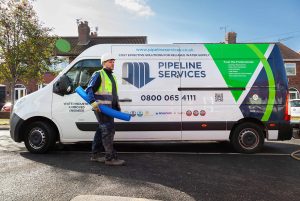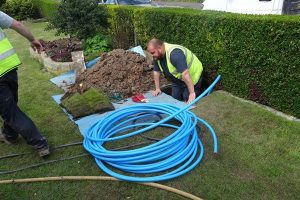 Thinking of water supply pipe replacement? This article covers costs, materials and hiring the right contractor. Learn what to expect to make your replacement stress-free.
Thinking of water supply pipe replacement? This article covers costs, materials and hiring the right contractor. Learn what to expect to make your replacement stress-free.
- The average cost to replace a water supply pipe is £1,000 for 10 meters, depending on material and installation complexity.
- Common water supply pipe materials are copper, PEX and PVC, each with its own benefits, costs and longevity implications.
- Key factors that affect replacement costs are pipe material, labour rates and excavation methods, all of which should be considered for budgeting and planning.
Call us today for a free quote on: 0800 065 4111
Water Supply Pipe Replacement Cost
Replacing a water supply pipe is a big investment; the average cost for a 10-meter pipe is £1,000. Costs vary depending on pipe material and installation complexity.
A section of pipe costs between £100 and £200 per metre, depending on the material. Key points to consider:
- Common pipe materials: Copper and MDPE, each with different price ranges and benefits.
- Longer pipe lengths increase material and labour costs.
- Initial material costs have a big impact on the overall budget.
Regional costs also vary, with London and the South East being more expensive. Installation complexity increases costs, especially if the distance from the internal stop tap to the property is longer. Knowing these variables helps with planning and budgeting.
Call us today for a free quote on: 0800 065 4111
Types of Water Supply Pipes
 Choosing the right type of water supply pipe ensures long-term performance and cost-effectiveness. Common materials are copper and MDPE.
Choosing the right type of water supply pipe ensures long-term performance and cost-effectiveness. Common materials are copper and MDPE.
Each has its own benefits and drawbacks, suited to different needs and preferences, with varying lifespans affecting long-term financial implications.
Knowing the typical applications of these pipes based on their properties helps to determine their suitability for different installation scenarios. Here’s a closer look at each to help you decide.
Copper Pipes
Copper pipes have been the gold standard in plumbing for years due to their durability and reliability. With a lifespan of 40 to 50 years, they are a long-term investment. Their robust nature means they can withstand high pressures and are less prone to leaks, making them ideal for cold and hot water systems. A plumber will often recommend copper for these reasons. Copper pipes are more expensive upfront and can corrode if the water is acidic. Despite these drawbacks, their longevity and performance often justify the higher cost.
Also, copper’s thermal conductivity makes it ideal for hot water systems, potentially saving energy costs in the long run.
MDPE Pipes
MDPE pipes are cost-effective and rust-resistant with a long lifespan. Their lightweight plastic nature makes them easier to transport and install compared to metal alternatives.
Labour Costs and Installation Timescales
 Labour costs for installing water supply pipes vary, typically between £60 and £80 per hour or charged per metre of pipe installed. Contractor experience, job complexity and location affect these rates.
Labour costs for installing water supply pipes vary, typically between £60 and £80 per hour or charged per metre of pipe installed. Contractor experience, job complexity and location affect these rates.
Hiring experienced professionals ensures better safety and quality, but at a higher cost. Installation complexity, like working in confined spaces or older infrastructure, can increase labour requirements and costs.
Installation methods also affect costs. Traditional trench excavation costs £100 to £125 per metre, while the trenchless method, known as Moling, costs £150 to £200 per metre.
Installing a 10 meter water supply pipe takes 1; larger plots can take considerably longer. The size of the area affects the total time required.
Key Factors Affecting Replacement Costs
Several key factors affect the overall cost of water pipe replacement:
- Pipe material
- Length of pipework
- Contractor rates
- Chosen excavation method
Each factor impacts both upfront and long-term costs. Access to the installation area is another important factor. Difficult access can increase labour and equipment needs, increasing overall replacement costs. Knowing these factors helps in making cost-effective decisions when planning your project.
 Length of Pipework
Length of Pipework
Pipework length is critical in determining replacement costs. Longer pipework means more material and labour costs. Properties further from the main water connection incur higher material and installation costs. If your property is far from the main water connection, more materials and labour are required, adding up to small amounts. These connections can add up to the overall budget when connecting to the main supply.
Type of Pipes Used
Pipe material selection affects initial costs and long-term maintenance costs. Copper piping is ideal for hot water systems due to its thermal conductivity, saving energy costs. MDPE pipes can be installed without joints in long runs, reducing leak potential and repair costs.
Choosing the right pipe material can save you money in the long run, affecting both installation and maintenance budgets. Consider both the initial purchase price and the long-term benefits and drawbacks of each material.
Excavation Methods
Excavation for pipe installation can add significant costs, including:
- Equipment hire.
- Traditional excavation is labour-intensive and has higher installation costs.
- Trenchless methods cause less property disruption and are more cost-effective in the long run.
- Considering both traditional and trenching methods can result in different cost implications and property disruption levels, including surface disruption, technology and directional drilling. The right method to dig depends on your situation and budget.
Building Regulations and Compliance
Complying with building regulations is important when replacing water supply pipes. Key points to consider:
- Approved contractors can do specific work without notifying water suppliers, speeding up the process.
- Completing forms and applying for local permits may be required.
- Permits are necessary if road closures or disruptions are involved.
Check existing pipes to see if they are lead before proceeding. Disposing of old pipes must follow Environmental Agency regulations, including recording their location and safely removing hazardous materials.
Lead and copper pipes can be recycled, but check with local centres if they accept ABS and PVC.
Lead Pipe Replacement
 Properties built before 1970 likely have lead pipes that can leach lead into drinking water, posing serious health risks. Key points:
Properties built before 1970 likely have lead pipes that can leach lead into drinking water, posing serious health risks. Key points:
- Replacing lead pipes reduces long-term lead exposure risks.* Eligibility for free pipe replacement may depend on the property type.
- Properties with children may have different free replacement criteria.
- Homeowners are responsible for replacing all lead pipework within their property boundary. In shared supply scenarios, homeowners must inform neighbours about lead pipe replacement work.
The United Utilities Lead Replacement Scheme helps homeowners upgrade from lead pipes to safer materials. Call us today for a free quote on: 0800 065 4111
Choosing the Right Contractor
Choosing the right contractor means a successful supply pipe replacement project. Key points to check:
- Contractor qualifications and experience.
- Certification, certified professionals reduce plumbing mistakes and water contamination risks.
- Insurance, particularly Public Liability Insurance.
Get at least three quotes to make an informed decision. A checklist for choosing a contractor should include:
- Qualifications
- Experience
- References
- Insurance
- Estimates
This ensures you hire a responsible and cost-effective option.
Removing Old Water Pipes
Removing old water pipes is part of the replacement process. Old pipework must be properly disconnected. Check if pipe removal is included in the contractor’s quote before proceeding.
If you choose to remove the pipes yourself, take them to a recycling facility. Check if your local recycling centre accepts them. Proper removal and disposal ensure compliance with environmental regulations and avoid potential hazards.
Other Considerations
When replacing water pipes, consider that planning permission is not usually required. Signs that you need to replace include:
- Corrosion
- Brown or rust coloured water
- Leaks
- Low water pressure.
While not necessary, getting a few quotes from contractors can help you get a competitive price for services with minimal effort. An example of how to arrange these factors in a contact form can help you plan better and avoid unexpected costs you might incur, making the process smoother.
Replacing water supply pipes is a big but necessary investment for water quality and property integrity. Knowing the costs, choosing the right materials and hiring qualified contractors is key to this process. By considering pipe length, material and excavation methods, you can make informed decisions and a smoother replacement process. Act now and protect your water supply and peace of mind.
FAQs
How much does it cost to replace a water supply pipe?
The cost to replace a typical water supply pipe is around £1,000, but this can vary depending on the pipe length and your location. Consider these factors when budgeting.
How much to replace a 30-meter water supply pipe?
£3,200 to replace a 30-meter water supply pipe. A key cost to consider for any plumbing work or repairs.
What materials are used for water supply pipes?
Copper and MDPE are common materials used for water supply pipes, each with its own benefits for different plumbing needs.
How does pipework length affect replacement costs?
Pipework length directly affects replacement costs; longer runs require more material and labour, resulting in a higher overall cost. A shorter design, when possible, can mitigate these costs.
What to consider when choosing a contractor for pipe replacement?
When choosing a contractor for pipe replacement, check their qualifications, experience and insurance, and get at least three quotes to make an informed decision.
Are lead pipes harmful?
Yes, lead pipes are harmful as they can leach lead into drinking water, especially in homes built before 1970. This can have serious health implications, especially for children and pregnant women.

 Length of Pipework
Length of Pipework

